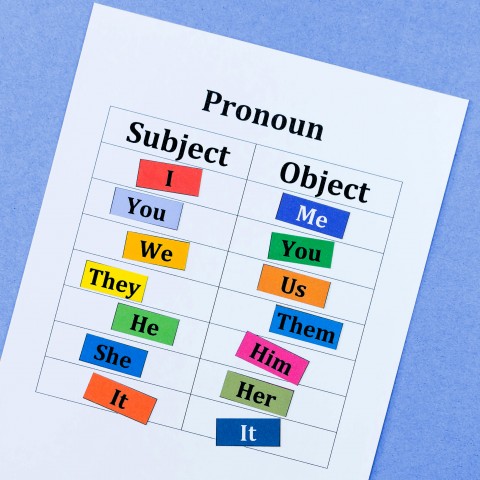

We’re so glad that you’re browsing this page because it means that you’re considering learning Hungarian—or have already started!
Now, we must say that although it is a beautiful language, Hungarian is also a bit challenging at times. That’s why it is so important for you to become familiar with the Hungarian grammar basics from the beginning.
This page is the perfect place to acquaint yourself with the ins and outs of Hungarian. From the word order to verb conjugation, and everything in-between, we’ll provide you with all the information you need to get a head start in your language learning journey.
But do remember that we’ll only be covering the basics of Hungarian grammar here. If you wish to study any of these topics further, HungarianPod101.com has tons of resources and lessons, some of which we’ve linked to throughout this lesson. In addition, you can find insightful articles on our blog page!
Are you ready to explore the world of Hungarian grammar with us? Let’s begin.

Table of Contents
First things first, we’ll quickly go over the most basic Hungarian grammar rules. Once you have a good understanding of these, you should have a much easier time learning the more complex concepts! To make things simpler for you, we’ll be using English as a benchmark and drawing comparisons between the two languages.
Once you feel comfortable with these rules, you can see our more-detailed explanations further down this page.
Let’s start with some good news: Just like English, Hungarian does not have grammatical gender. Phew!
Normally, English sentences are constructed using the Subject-Verb-Object pattern, making it an SVO language. Well, this is not the case in Hungarian.
Although there are instances where Hungarian uses the SVO word order too, Hungarian sentence structures are flexible and pragmatic. This means that words are ordered based on which word you want to give the most emphasis, and which the least. This gives speakers the freedom to better express themselves and make their points clear.
For this reason, super-long sentences can be structured any number of ways. You don’t have to worry much about making mistakes regarding the word order, because pretty much anything you say will be grammatically correct. The only thing that matters when forming sentences is that you put the right word—the one you want to emphasize—at the beginning.
In English, there are twelve major verb tenses. That’s quite a lot, huh?
Well, you won’t have to struggle with Hungarian that much, as it only has three verb tenses: past, present, and future. Pretty straightforward, right?
Also, once you learn the conjugation of regular verbs (and that of a few irregular verbs), forming correct sentences will be easy as pie.
Both English and Hungarian use cases. This means that, depending on what role a pronoun plays in a sentence (subject or object), there are slight changes to the word.
Take this sentence for example:
This sentence has two masculine pronouns, but “he” (the subject) is in the nominative case and “him” (the object) is in the accusative case.
In English, the case system is fairly simple. But in Hungarian grammar, cases are a bit more challenging and require the memorization of quite a few suffixes.

As we mentioned earlier, Hungarian normally uses the SVO word order in sentences, but there’s not a set word order that one must follow. The speaker decides how they want to structure their sentences. But for this reason, they also have to remember that their word placement will impact the overall meaning of the sentence in terms of emphasis.
In Hungarian grammar, word order is based on the following rules:
The most important words—the ones you want to emphasize—go at the beginning of the sentence. In speech, you might also emphasize them vocally by putting stress on them.
For example, each of the following variations means, “The girl sews in the house.” But each one places emphasis on a different part of the sentence.
Words of negation are always at the beginning of a Hungarian sentence.
The focus of the sentence is usually the word before the verb.
Let’s take a look at a couple of the sentences from above and see how this applies to them.
Házban means “in the house,” and it’s the focus of this sentence, indicating that she sews in the house and nowhere else. Following the “focus word” is varr, the Hungarian verb for “(she) sews.”
The focus here is on the negating word ne, which is the most important part of the sentence. Following it is the verb mondd.
As you can see, the Hungarian sentence structure is rather flexible. To make sure you have a good grasp of this concept, let’s look at a final example.
Here, the speaker wants to let us know that he loves the girl in question, which is why the Hungarian word szeretem (“I love”) is at the beginning.
But what if we switched the word order?
This structure indicates that the speaker loves her (őt) specifically, and is not fond of anybody else. Here, the girl who is being loved is important, not the fact that the speaker loves her.

Now that you know about the Hungarian word order, let’s fill in another piece of the puzzle: verb conjugation.
Conjugation refers to the way that a verb changes according to factors such as voice, mood, tense, number, and person.
In Hungarian grammar, verbs can be:
❖ Singular or plural
❖ Undetermined or determined
❖ Realis mood, conditional mood, or imperative mood
Because Hungarian is an agglutinative language, conjugation is done by attaching suffixes to the end of verbs. These suffixes indicate if the verb is in first, second, or third person. For this reason, Hungarians don’t use personal pronouns unless they want to emphasize the subject.
The suffixes also give away whether we’re talking about one person or multiple people (in other words, whether the subject is singular or plural).
Below, you can see all of the possible verb endings regarding person and number. Here, the definite conjugation endings are in bold, whereas the indefinite conjugation suffixes are in italics.
| Definite Conjugation Endings | Indefinite Conjugation Endings | |
| I (Én) | -m | -k |
| You (Te) | -d | -sz, -l |
| He / She / It (Ő / Az) | -ja, -i | ∅ |
| We (Mi) | -juk, -jük | -unk, -ünk |
| You (Ti) | -játok, -itek | -tok, -tek, -tök |
| They (Ők) | -ják, -ik | -nak, -nek |
Let’s look at the topic of definite versus indefinite conjugation in more depth.
When to use indefinite conjugation:
When to use definite conjugation:
It’s crucial that you learn this aspect of Hungarian grammar properly, so that you’ll know whether to use a definite or indefinite Hungarian verb conjugation ending. This is important because a person might appear uneducated if they neglect to use the -m ending for the first person singular present form of -ik verbs.
Hungarian “-ik verbs” are the spoken forms of a word, also known as the citation forms for when a verb stands alone. For example, -ik verbs are what you would find in Hungarian dictionaries. They’re called -ik verbs because their last syllable is -ik.

Another crucial part of Hungarian grammar is the cases, of which there are five types:
2. Attributive / Possessive
Please note that the first three are also called “subjective cases” because they can stand as subjectives as well.
Hungarian nouns have eighteen cases, which are formed by adding suffixes to the stem. The nominative case, for example, has no suffix. The accusative case, on the contrary, is marked with the suffix -t. For example:
| Nominative | a könyv “the book” |
| Accusative | (Értékelem) az könyvet. “(I appreciate) the book.” |
Most of the cases are a combination of the source-location-target and surface-inside-proximity ternary distinctions (three times three cases). There is also a separate case ending, -ból/-ből, which means “from inside of.” For example, “from the school” would be iskolából.
Let’s take a moment to focus specifically on the attributive (possessive) case, as this trips up many new Hungarian learners.
The attributive case has two suffixes, which are -nak (for flat-sounding words), and -nek (for sharp-sounding words). This case can also be called the “possessive case” as it expresses possession of something. This case stands in an adjectival relation to the thing that is being possessed, and therefore also serves as an attribute of the thing being possessed. Here’s an example:
(Péter is a flat-sounding word.)
Here, Peter is the possessor, and the book is the thing he possesses. Peter is also an attribute of the book (the book is defined as being owned by him).
(Anya is a sharp-sounding word.)
Also, possession in Hungarian grammar is expressed by a possessive suffix on the possessed object (just like above). This is opposite to how this is expressed in English, where the possessor takes the suffix. Take a look:
Another difference between Hungarian and English is that Hungarian does not have a verb meaning “to have.” Rather, Hungarians express possession by using the attributive case with the verb van (“to be”). For example:
Do you need a little more help with the attributive case and showing possession? Don’t worry! HungarianPod101.com has you covered with the following lessons:

In this last section, we’re going to introduce you to a few more practical Hungarian grammar rules. They might seem expendable at first glance, but they’re just as important as the topics we covered in the previous sections.
One of the matters we’d like to talk about is gradation in Hungarian.
Unlike English, Hungarian does not express gradation through stand-alone words. Instead, the language expresses it with prefixes and suffixes. More specifically, with the prefix leg- (“the most” or “-est” in English) and with the suffix -bb (“more” or “-er” in English).
Here are some examples to give you a better idea of what we mean:
The next thing you should know about Hungarian grammar is that it has particles. Actually, it’s very rare that a Hungarian verb does not have a particle attached to it. Anytime there’s a Hungarian verb, it will almost certainly have a particle.
This is important to know because, sometimes, Hungarians answer questions with the particle alone, omitting the verb.
Take a look at what we mean by this:
Now, this might be the most important (or should we say legfontosabb?) rule. Hungarians greatly appreciate a little politeness.
In Hungarian grammar, you can form sentences in one of two ways depending on the politeness level you wish to convey. In this sense, Hungarian is more like French (where ‘tutoyer’ and ‘vouvoyer’ exist) than like English.
In Hungarian, you can hit a friendly note with a friend, family member, or acquaintance. But you should opt to use Ön and a more polite tone with people you don’t know. Also, if the other person is older than you or deserving of your respect (like a teacher, for example), you should be more polite.
Now, as you know, Hungarian grammar tends to drop pronouns since the verb conjugation reflects the pronoun already. When using Ön, you should use the third person singular form of verbs.
Let’s see a few examples of informal vs. formal Hungarian:
| Friendly / Informal | Polite / Formal | |
| “How are you?” | Hogy vagy? | Hogy van? |
| “Do you know what time it is?” | Tudod, mennyi az idő? | Tudja, mennyi az idő? |
| “You don’t have to wait.” | Neked nem kell várnod. | Önnek nem kell várnia. |

In summary, we covered a variety of practical Hungarian grammar concepts that you should learn as a beginner. From word order to conjugation and special rules, you should now have a much better understanding of basic grammar points.
And now that you’re somewhat familiar with the most common Hungarian grammar rules, you can dive deeper.
All you have to do is join the HungarianPod101 family.
If we’ve inspired you to continue in your Hungarian studies, create your free lifetime account today and start speaking real Hungarian from your first lesson. You’ll find tons of vocabulary lists, blog posts, video and audio lessons, and much more when you sign up. And don’t forget that should you encounter any troubles during your language studies, we’re always here to help!
With us, language learning has never been easier.
Before you go, let us know in the comments which Hungarian grammar concepts you find easiest and the most difficult. We look forward to hearing from you!